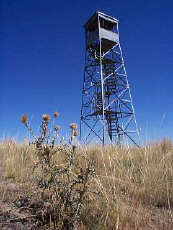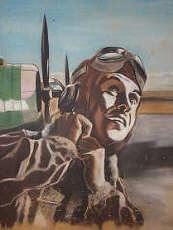 |
|
WW II’s Casper Army Air Field kept watch in Wyoming. An abandoned gunnery range tower still stands. |
![]()
Riverton, Wyoming
September 11, 2001 and December 7, 1941: dates that will live in infamy.
Like its 1940s counterpart the September World Trade Center and U.S. Pentagon terrorist bombings have jolted Americans into reality. As with the Japanese Pearl Harbor attack 60 years ago, citizens now face a potentially extended and brutal military conflict.
Shock is felt nationwide. The unthinkable has occurred. The continental United States is invaded.
Understandably these events leave us stunned. But oddly enough, and as unprecedented as the September bombings seem, they are not the first intrusion.
Yes, the continental U.S. has been attacked before and within recent memory. It occurred extensively between November 1944 and April 1945, when the Empire of Japan launched thousands of bomb-laden, pilot-less hydrogen balloons toward North America’s national forests.
Backcountry hikers take note: crashed balloon parts were reportedly located as late as 1987, on a North Dakota farm. Admittedly, that’s a rare find, but not surprising. Experts say about 9,000 of these bizarre and insidious devices attempted the Pacific Ocean crossing.
About 285 are estimated to have landed, mostly in the western U.S. and Canada. But even with a balloon design flaw that forced the majority into the sea prematurely, odds are there’s still a few lurking just off the trail.
Here in Wyoming six reportedly crashed, floated to earth or outright exploded – fortunately without injuring anyone. Most notable was the November 6, 1944 Thermopolis event that occurred about 15 miles northwest of that community, just off Highway 120 leading to Yellowstone National Park.
 |
|
Hand-painted mural in the old CAAF Enlisted Men’s Club. |
![]()
Ironically it hit near some Native American petrogylphs. But apparently their magic wasn’t enough to keep the device’s 15 kilogram anti-personnel iron bomb and incendiary projectiles from going off. However there were witnesses, so it wasn’t long before the FBI carted away fragments and parts for examination.
June Mueller with the Hot Springs County Historical Museum in Thermopolis was younger then and recalls the incident. Ominously, she says authorities’ biggest fear was not explosives, but exposure to Japanese biological weaponry.
Fortunately balloon bomb historians agree that while such concerns were valid at the time, Japan never used bio weapons – at least in North America. Nevertheless, the bombs were potentially destructive. Had they crashed in summer extensive wildfires could have resulted.
Indeed this was Japan’s plan for our national forests. But inexplicably the attacks primarily occurred in wet or snowy weather. Most noted among these were two Pacific Northwest explosions where, by chance, one balloon fell on the Manhattan Project’s Hanford Nuclear Reservation in Washington state. It briefly halted work on the yet-untested atomic bomb.
Tragically, farther south in Oregon a balloon killed six hikers when they reportedly tugged its rigging and triggered the iron bomb. Travelers may view this site and its stone memorial near the town of Bly, where the incident occurred in early May 1945.
 |
|
A captured Nazi V-1 propellant tank rests at Nevada’s semi-abandoned Wendover Army Air Field – another flying threat. |
![]()
Back in Wyoming, viewing the Thermopolis balloon’s remains may also be possible if a search for them is successful. The historical museum’s Mueller says the U.S. government returned these artifacts to the town during the early 1980s. However, with time their location has receded from memory.
Such is history. Painful events are what they are, and often they mercifully fade.
In some ways perhaps forgetfulness is best, but in light of current events remembrance also has merit. Personally, it would be interesting to see these remains to recall a time that seems hauntingly similar to our own.
Perhaps during 60 years of relative peace, punctuated only by overseas wars, we too have forgotten what a dangerous place the world is.
But now terror strikes home. A good history lesson may help us deal with that.